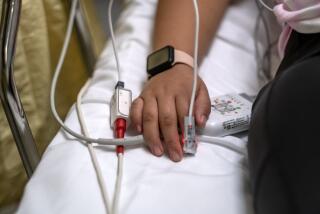Area Hospitals Are Swamped With Flu Patients
- Share via
Los Angeles hospitals reported severe emergency room overcrowding Friday after being swamped by patients suffering from the flu, respiratory ailments and other serious conditions.
The situation was so extreme that half the region’s 84 public and private acute care general hospitals were asking that patients be routed to other hospitals, according to Jim Lott of the Healthcare Assn. of Southern California.
But ambulance dispatchers were telling those hospitals to find room, because so few emergency rooms anywhere had empty beds. As a result, doctors and nurses were doing triage to identify the sickest, forcing those with less severe problems to endure long waits.
“We have no beds anywhere in the hospital,” said emergency room physician Jon Lawrence, who was working at Saint Mary Medical Center in Long Beach on Friday night. “We have no emergency room beds, no ICU beds. Every other hospital in Long Beach is exactly the same way.”
In Orange County, hundreds of people suffering from flu-like symptoms, bronchitis or pneumonia created such severe overcrowding that seven medical centers were forced to temporarily close their emergency rooms.
Each year, flu and other viruses take an enormous toll during December and January.
But hospitals say their situation this year is particularly bad because the flu outbreak is caused by a particularly virulent virus, and high winds and dramatic changes in weather have created severe problems for those suffering from asthma and respiratory ailments.
Although several hospitals said Friday they were experiencing the normal numbers of winter flu cases, facilities regionwide were “seeing about one-third more patients now than this time last year,” Lott said.
He said hospitals are canceling staff vacations and time off to meet the demand.
“Nobody is turning away patients,” Lott said, “but many hospitals are saying they are at capacity, and that could mean longer waits for some patients.”
Linked by an electronic web of telephones and computers, hospitals are in constant communication with centralized dispatch centers, usually located in an acute care hospital.
When an ambulance or paramedic team is dispatched to deal with a medical emergency, the dispatch center begins looking for the closest emergency room. When the beds fill up, hospitals ask that patients be diverted elsewhere.
But occasionally the patient load becomes so heavy that hospitals are forced to accept new patients even if there isn’t room.
At Childrens Hospital Los Angeles, Dr. Calvin Lowe said his emergency room was 15% to 25% busier than it was a year ago. The intensive care unit was full Friday night.
Lowe said he was seeing a high number of children with respiratory illness.
Children “don’t have the energy reserves to combat infections,” Lowe said. “They can be hit very hard, and they can spiral down quickly.”
Saint Mary’s Lawrence said the flu and viral infections started “with children a couple of weeks ago. Now the adults have it, too.”
The hospital association said it was urging people with true emergencies to continue to use hospital emergency rooms.
More to Read
Sign up for Essential California
The most important California stories and recommendations in your inbox every morning.
You may occasionally receive promotional content from the Los Angeles Times.













